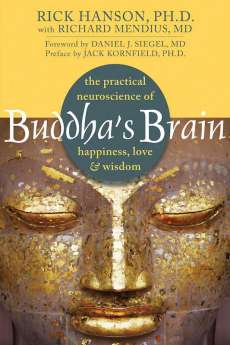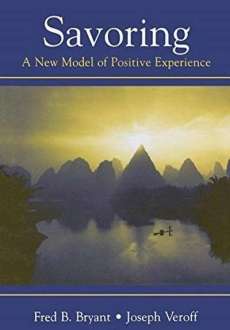FEATURES|COLUMNS|Art of Living
How to Enjoy Life Twice as Much, Part 1: Michel de Montaigne and Rick Hanson on Life’s Natural Pleasures

The widely respected contemporary neuropsychologist Rick Hanson has developed a simple, evidence-based technique (endorsed by everyone from Thich Nhat Hahn and Sharon Salzberg to Daniel Siegel and Tara Brach) for turning fleeting positive states into long-lasting neural traits. (Hanson 2013, xxi) In a nutshell, Hanson recommends that we first bring positive experiences—whether a compliment, a humorous interaction with a friend, the completion of a difficult email, or a night sky crammed with twinkling stars—from the background of our awareness into the foreground and fully attend to the associated emotions and sensations. (Hanson 2013, 61) Then, to ensure that they are salient enough to be encoded in our implicit memories, he encourages us to “enrich” them by intensifying the positive sensations and emotions for 10 or more seconds. (Hanson 2013, 111) Finally, Hanson invites us to “absorb” our positive experiences by sensing them sinking into our bodies and imagining ourselves internalizing the them by, for example, visualizing them sifting down into us like a golden dust, or feeling them easing us like a soothing balm. (Hanson 2013, 119)
 From ebooks.com
From ebooks.com Rick Hanson. From happify.com
Rick Hanson. From happify.comWhile Hanson gratefully acknowledges that his technique draws on the work of many prior figures (Hanson 2013, xxii)—notably Siddhartha Gautama and the pioneer of savoring research, Fred Bryant—another figure he might have humorously accused of what Robert Merton calls “anticipatory plagiarism” (“when someone steals your original idea and publishes it a hundred years before you were born”)—is the celebrated French essayist Michel de Montaigne, who clearly articulated the same basic processes at the heart of both Rick Hanson’s and Fred Bryant’s work not just 100 years before they were born, but closer to 400.
In fact, with a great deal of respect and a tremendous amount of gratitude to researchers such as Bryant and Hanson, it seems to me that with the exception of a few very important elements (like the simple and accessible neuroscientific explanations that Hanson provides, and the conceptualizations and randomized controlled trials that Bryant has conducted) there’s not really that much they’ve turned up that Montaigne hadn’t already expressed in a few short pages of his essay “On Experience” in the late 1500s. And if you ask me, this is great news. The fact that Montaigne’s reflections on savoring anticipate, to a striking degree, a great deal of recent empirically validated research doesn’t just lend scientific credibility to Montaigne’s method, it also bolsters the recent research on savoring by showing that it has deep and ancient roots not only in Buddhism but also in the work of one of the most influential philosophers in Western history.
 Statue of Michel de Montaigne at the Sorbonne. From pinterest.com
Statue of Michel de Montaigne at the Sorbonne. From pinterest.comMontaigne’s method for enjoying life twice as much
So what was Montaigne’s method? Near the end of his life, near the end of the last essay he ever wrote, Montaigne boasts that he “enjoy[s] life twice as much as others.” (Montaigne 1957, 1,040) The secret to his success? First, he knows that he has to work at it. In fact, in his view, “There is . . . no knowledge so hard to acquire as the knowledge of how to live this life well and naturally.” (Montaigne 1957, 1,039) This is largely because, for Montaigne, being “expert and versed in the enjoyments of natural pleasures” is a very specific skill that has to be developed in the same way one develops the ability to play a musical instrument, or paint, or manage a farm. (Montaigne 1957, 1,037) Indeed, he explicitly emphasizes that “to enjoy life requires some husbandry,” implying that enjoying life requires the same kind of care, hard work, knowledge, and attention that is required to raise crops and animals. (Montaigne 1987, 703) In fact, just as a farmer or a gardener might boast about their techniques for raising pigs or harvesting lettuce, Montaigne emphasizes that he cultivates what he calls the “natural pleasures” or “natural enjoyments” of life both “carefully” and “particularly” (Montaigne 1949, 237)—Montaigne uses the words “natural pleasures” and “natural enjoyments” in a very broad sense so as to include sensory pleasures such as eating and drinking and sex, emotional pleasures such as tranquility, happiness, and well-being, intellectual pleasures such as reading and conversing and imagining, and aesthetic pleasures such as delight and awe and appreciation of nature. So what exactly does Montaigne’s careful and particular approach to cultivating the enjoyments of life entail? These are the key points:
1) Make a point of taking time out to enjoy the natural pleasures of life;
2) Give your full attention to enjoyable experiences;
3) Let go of any inhibitions preventing you from fully enjoying yourself;
4) Prolong your positive experiences;
5) Interact with your enjoyable experiences in a sensory way;
6) Appreciate and amplify your positive experiences;
7) Give yourself over to your pleasures and “join” in them;
8) Acknowledge the transience of enjoyable experiences and relinquish them.
Let’s look at each of these points in turn, and then compare them very briefly to the evidence-based work of Rick Hanson, Fred Bryant and others.
1) Make a point of taking time out to enjoy the natural pleasures of life
How did Montaigne, by his own account, “enjoy life twice as much as others”? First of all, he valued and prioritized enjoying the natural pleasures of life. More specifically, by his own account, he paid twice as much attention as his peers to enjoying life: “I enjoy it twice as much as others, for the measure of enjoyment depends on the greater or lesser degree of attention that we give it.” As Montaigne aged, he paid an increasing degree of attention to his moments of enjoyment. Why? Because he had come to the simple conclusion that this is one of the most important components of a life well lived. As the intellectual historian J. J. N. McGurk writes of Montaigne: “His ideal human being is . . . a lover of life who is convinced of the legitimacy of pleasure, the importance of the body, and the goodness of happiness.” As a result, Montaigne rebukes those who he hears say of another man, “He has spent his life in idleness,” as well as those who grumble, “I have done nothing today.” Instead, he asks, “What, have you not lived? That is not only the fundamental but the most illustrious of your occupations.” For Montaigne, to “think out and manage [our] own life,” to “compose our character,” and to establish “order and tranquility in our conduct,” is not only “the greatest task of all,” but our “duty.” And it is a duty that, in his view, trumps all other conceivable duties, including our “occupations” no matter how “illustrious” they might be: “My business, my art, is to live my life.” (Montaigne 1987, 2:6) To Montaigne, who is widely regarded as one of the greatest literary artists in Western history, there is no art more important than the art of living: “Our great and glorious masterpiece,” he says, “is to live appropriately.” (Montaigne 1957, 1,037)
One of the most important elements of “living appropriately,” in Montaigne’s view, is knowing how to effectively enjoy life’s enjoyable moments. In fact, like many of his favorite philosophers (most notably Epicurus), he expects “the perfect sage to be as expert and versed in the enjoyments of the natural pleasures as in any other duty of life.” (Montaigne 1957, 1,037) For example, in Montaigne’s opinion, none of Socrates’ extraordinary accomplishments was more admirable than the fact that he took the time when he was old to learn how to dance and play instruments and kid around with children, playing games with them while pretending to ride a hobby horse. But being both experienced and skilled at enjoying simple pleasures is certainly not, in Montaigne’s opinion, the exclusive provenance of “sages” such as Socrates. It is a skill he finds in the lives of all of the “strong and great-souled” individuals he admires, even (and perhaps especially) those who are laboring under the weight of great responsibility, great stress, and great danger. Steeped as he was in ancient Greek and Roman history, living in an age of ongoing military conflicts, and writing for an audience that greatly esteemed military strategists, most of the examples he gives are of ancient Greek or Roman generals. For instance, he writes approvingly of the way that both Julius Caser and Alexander the Great savored moments of enjoyment, even in “the thick of their exploits.” He relishes reading about a general in the field at the foot of a breach he is about to attack “giving himself wholeheartedly to his dinner while chatting freely with his friends.” (Montaigne 1957, 1,259) Likewise, he is thrilled to read that even when he was on the verge of being defeated in the battle that ensued after the assassination of Julius Caesar, Brutus still took time out from his evening duties to read and take notes “with complete composure” on Polybius, his favorite historian. Similarly, when Montaigne considers all the accomplishment of the Roman general Scipio (generally regarded as one of the greatest military commanders and strategists in Western history), he concludes that the most commendable of all his actions was when, late in his life, he was spotted “idling along, unperturbed, choosing and collecting shells like a schoolboy, playing Quick! Quick! Pick up Sticks with [his friend] Laelius on the seashore.” In contrast to these “great-souled” individuals who knew how to enjoy themselves even in the midst of great responsibilities, Montaigne writes, “It is for petty souls overwhelmed by the weight of affairs to be unable to disentangle themselves from them completely, not knowing how to drop them and then take them up again.” (Montaigne 1957, 1,260)
An abundance of recent research supports Montaigne’s emphasis on the importance of taking time out to relish enjoyable activities. Among many other benefits, positive emotions such as joy, relaxation, excitement, and affection have been shown to reduce reactivity and stress, help us settle down when we’ve become frustrated or worried, and increase life satisfaction, well-being, and resilience. (Cohn 2009; Feldman 2008; Fredrickson 2007) Research also shows that the experience of positive emotions, such as pleasure or enjoyment, encourages the pursuit of opportunities, increases our motivation to continue activities, and promotes success. (Lyubomirsky 2005) Finally, positive emotions also strengthen our immune systems, protect our hearts, and help us live healthier and longer lives. (Diener and Chan 2011)
Just as Montaigne maintains, however, contemporary psychologists such as Rick Hanson and Fred Bryant emphasize that we must go through a “careful” and “particular” process of responding to them if we want them to have lasting effects. If we don’t, Hanson, Bryant and many others warn us that, aside from the occasional “million-dollar moment,” our enjoyable experiences simply won’t be converted into neural structures and will therefore have little or no lasting effect on the implicit memory systems in our brains. (Hanson 2013, Chapter 2)
 Montaigne’s tower. From pinterest.com
Montaigne’s tower. From pinterest.com Montaigne’s study. From pinterest.com
Montaigne’s study. From pinterest.com2) Give your full attention to enjoyable experiences
In addition to prioritizing the enjoyment of life, Montaigne gave his undivided attention to his actual experiences of enjoyment. Indeed, over the course of his life, he trained himself to give all of his attention to almost everything he did. At one point he even claimed, “I customarily do wholeheartedly whatever I do, and go my way all in one piece.” (Montaigne 1957, 747) But by his own account he was never more wholehearted than when he was in the midst of enjoyable experiences. As he famously wrote of two such experiences of pleasure, “When I dance, I dance; when I sleep, I sleep.” As he aged and his physical reflexes slowed, his mental reflex of catching fleeting moments of pleasure only sharpened: “Even the slightest occasions of pleasure that I can come upon, I seize.” (Montaigne 1957, 1,259)
But Montaigne doesn’t just give his full attention to enjoyable experiences; he does this deliberately and knows that he is doing it. Taking the pleasure of sleep as the most extreme example, he writes: “To the end that sleep itself should not escape me thus stupidly, at one time I saw fit to have mine disturbed, so that I might gain a glimpse of it.” (Montaigne 1957, 1,040) In other words, Montaigne was so determined not to sleep his way through any of his enjoyable experiences that he even made an effort to be awake while he was asleep. This is similar to Gautama’s famous advice from the Satipatthana Sutta: “When walking, the monk knows, ‘I am walking.’ When standing, he knows, ‘I am standing.’ When sitting, he knows, ‘I am sitting.’ When lying down, he knows, ‘I am lying down.’” Moreover, just as Gautama recommends, when Montaigne’s mind periodically does drift away from the here and now, he simply “leads” his mind back to his pleasant experience and stays with it: “When I walk alone in a beautiful orchard, if my thoughts have been concerned with extraneous incidents for some part of the time, for some other part I lead them back again to the walk, to the orchard, to the sweetness of this solitude, and to myself.” (Montaigne 1957, 1,036)
But there are a couple of important differences between the two figures’ approaches. First, unlike Gautama, Montaigne pays special attention to moments of pleasure and enjoyment (e.g. dancing, sleeping, walking through an orchard). Second, rather than restricting his attention to moments of enjoyment in the present, he also makes a point of actively summoning pleasant memories from the past, especially when he is in the midst of distress. For instance, he does not hesitate to “divert by trickery the gloom of old age” by “hunting” down and reliving bygone pleasures: “Lest my mind should dwell intensely on its ills, I turn very gently aside and make my eyes steal away from such stormy, cloud-wracked skies as lie before me: . . . and I find myself spending my time recalling my past youth.” (Montaigne 1957, 775) By emphasizing that he “turns very gently aside” from his current “ills” here, he makes it clear that he is not trying to escape the present by living in the past. Instead, guided by the desire to maintain emotional moderation (the “golden mean” that he openly proclaims he “worships”) he simply wants to avoid dwelling too “intensely” on his ills. In fact, Montaigne says, “As long as my eyes can discern that lovely season now expired, I turn them in that direction at intervals. If youth is escaping from my blood and my veins, at least I want not to uproot the picture of it from my memory.” (Montaigne 1957, 775) Indeed, to give his declining libido a boost he even says, “I deliberately let myself go a bit to license and sometimes occupy my soul with youthful wanton thoughts to give it a rest.” (Montaigne 1957, 775)
Again, recent neuroscience backs up Montaigne’s emphasis on the importance of deliberately directing our attention to those events we wish to be permanently effected by. As the Nobel-Prize-winning biologist Eric Kandel and others have shown, whatever we repeatedly sense and feel and desire and think slowly but surely sculpts the neural structures of our brains. (Kandel 1998) As Rick Hanson puts it: “The brain takes the shape the mind rests upon.” If we rest our minds on sadness, worry, annoyance, and irritability, our brains will begin to take the neural shape of anxiety, depression, and anger. If, on the other hand, we rest our minds on moments of enjoyment and pleasure, our brains become better at finding things to take pleasure in, and begin to take the shape of enjoyment. This is what neuroscientists call “experience-dependent neuroplasticity,” the core insight of which is often simplified in an aphorism that summarizes the key finding of Donald Hebb’s work: “Neurons that fire together, wire together.” If we don’t pay much attention to an experience, it doesn’t have much effect on our brains. On the other hand, if we pay a lot of attention to an experience, it does. As Rick Hanson emphasizes, “Intense, prolonged, or repeated mental/neural activity— especially if it is conscious—will leave an enduring imprint in neural structure, like a surging current reshaping a riverbed.” (Hanson 2013, 10) If we want to increase our enjoyment of life, therefore, it stands to reason that we should pay more attention to our enjoyable moments. Recent researchers refer to this process as savoring, which Fred Bryant, the pioneer of savoring research, defines as “the capacity to attend to, appreciate, and enhance the positive experiences of life.” (Bryant, 2006, xi)
 From allegro.pl
From allegro.pl Fred Bryant. From researchgate.net
Fred Bryant. From researchgate.netVery much like Montaigne, a person who savors an experience is doing something slightly different from a person who is practicing mindfulness. As Bryant observes, “Positive experiences must include some degree of mindfulness for them to be savored.” (Bryant 2006, 76) However, unlike people who are merely mindful of their positive experiences, Bryant point out: “People who savor, by contrast, deliberately attend to positive feelings and to those experiences that are making them feel good.” (Bryant 2006, 16) Here’s how he captures the distinction:
When people savor, they too are mindful of their experience, but their attention does not remain totally open to incoming or internal stimuli. Instead, the savoring process involves a more restrictive focus on internal and external stimuli associated with positive affect. In that sense, savoring is a narrower concept than mindfulness. (Bryant 2006, 15)
Rather than turning away from the enjoyable thoughts or pleasant feelings that might be arising in the moment, when one savors, one intentionally attends to these experiences, “mulling them over,” as Bryant writes, “or ‘swishing them around in one’s mind,’ so to speak, as one would savor a fine wine on one’s palate.” (Bryant 2006, 16)
Moreover, consistent with Montaigne’s practice of deliberately summoning positive memories to boost his enjoyment of life, Fred Bryant and his colleagues have conducted two studies showing that savoring pleasant memories increases reported levels of happiness. (Bryant et al 2005) One of these studies revealed that people who reminisced over positive memories showed greater increases in the percentage of time they felt happy during the previous week, compared with participants in a control group. This result was consistent with an earlier study that also showed a positive correlation between happiness and the frequency of positive reminiscence. Taken together, Bryant concludes that these studies “demonstrate that positive reminiscence can boost happiness.” (Bryant and Veroff 2006, 150)
Influenced by Bryant, Rick Hanson recommends an approach similar to Montaigne’s. As he often repeats, just as a person suffering from scurvy will not be helped by Vitamin D, or a person who has run out of gas won’t be helped if you offer them a boost, we need to match the appropriate resources to our needs-deficits. As a consequence, like Montaigne who actively moderates his concerns about sickness, aging and dying by calling up pleasant memories from his youth, in order to counterbalance feelings of isolation or rejection, for example, Hanson recommends we deliberately bring to mind and bask in memories of belonging and inclusion. (Hanson 2013) To offset a driven quality of unhealthy craving prompted by an underlying feeling that one is not enough in some way, he recommends we intentionally bring to mind memories of all the goals we’ve already achieved and then marinate in the feeling of being “already successful.” Clearly, for Hanson, as for Montaigne, internalizing pleasures is clearly not only pleasing in the moment, but leaves behind traces in the memory that allow us to pull them up later and be relieved, reassured, and renewed by them. (Hanson 2013)
 Michel de Montaigne. From twitter.com
Michel de Montaigne. From twitter.com3) Let go of inhibitions preventing you from enjoying yourself
While it might sound obvious that if you really want to enjoy your life, you need to begin by prioritizing moments of enjoyment and then pay more attention to such moments, in Montaigne’s day, as in ours, there were a number of common inhibitions that often prevented people from doing so. Montaigne doesn’t speak about them in exactly these terms, but he basically identifies three main things you should do if you really don’t want to enjoy your life.
First, if you are determined to not enjoy your life, he says you should not only intentionally avoid feeling pleasure but actively cultivate a sense of disgust with it. Perhaps because a puritanical strain of Christianity was so influential during his time, Montaigne suggests that the mind, everybody’s mind, is a natural killjoy: “Our morbid spoilsport of a mind . . . causes [our pleasures] to taste as unpleasant to us as it does to itself.” If you let your mind spoil your pleasures in this way, in addition to not enjoying your life, you will also earn Montaigne’s utter contempt. Because he considers the pleasures of the body as natural as breathing, he not only berates ascetic prudes who renounce all pleasure by asking them, “Why do they not also give up breathing?” he also lampoons their absurd hypocrisy: “Won’t they try to square the circle while perched on their wives.” He makes his own position abundantly clear: “I, who operate only close to the ground, hate that inhuman wisdom that would make us disdainful enemies of the cultivation of the body.” (Montaigne 1957, 1,036)
A second way to be sure you don’t enjoy your life is to go ahead and allow yourself to enjoy the natural pleasures of life, but do so unconsciously by making sure you’re preoccupied or distracted during moments of relaxation, gratitude, or generosity. Montaigne observes that most of the people he knows who do allow themselves to experience moments of pleasure do so “as they do that of sleep, without being conscious of them.” (Montaigne 1957, 1,040) In other words, they feel pleasure but they are unaware that they are feeling it and therefore miss out on it. Why? There are two reasons. First because most people, in Montaigne’s view, “pass the time” during their moments of enjoyment by getting caught up in distracting “pastimes.” Second, because they become “slaves of hope” by becoming so enchained with fantasies of future satisfaction that they miss out on the pleasures right there under their noses. Consequently even those of his peers who do, like him, “feel the sweetness of happiness and well-being,” unlike him, feel it only “in passing, as it slips by” because they aren’t aware or conscious that they are experiencing it, and therefore do not extend or prolong their experiences of pleasure. Again, Montaigne has little patience for such people. Not only does he approvingly quote Seneca’s observation that “the life of the fool is joyless, full of trepidation, given over wholly to the future,” but he also maintains that “we have only ourselves to blame if [life] weighs on us and if it escapes us unprofitably.” (Montaigne 1957, 1,038)
A third and final way to ensure you do not enjoy your life is by getting caught up in dwelling on life’s difficulties. Montaigne himself was no stranger to adversity. When he was in his 30s, his best friend, his father, his younger brother, his first baby, and very nearly he himself died, leaving him with an almost debilitating fear of death. (Bakewell 2010, Chapter 1) Later in his life, however, he compares “bad” experiences to bad weather and rather than encouraging us to stand outside in the rain or complain about the cold, he invites us to make a deliberate choice to “pass the time” when unpleasant experiences are occurring. (Montaigne 1957, 1,039) As he plainly states, “We must hasten over the bad and settle upon the good.” (Montaigne 1957, 1,040) Montaigne’s preferred method of “hastening over the bad” was “diversion,” a strategy he had recourse to many times over the course of his life, as he himself recounts in his essay “On Diversion” and elsewhere. To take just one example, when his best friend La Boetie died, Montaigne was, by his own account, “afflicted with an overpowering grief” that he says might have “destroyed” him if he “had trusted simply to [his] own powers.” Sensing that he needed some “violent diversion” to shift his attention away from his loss, as his biographer Donald Frame says, he spent “two years . . . distracting himself from grief in various love affairs.”
It’s not that Montaigne ignores or denies or suppresses unpleasant experiences. No, in addition to viewing pleasure and pain as inextricably intertwined, he is also very much of the opinion that pain is not only a natural and inevitable part of life, but a “necessary medicine.” “Necessary” because it is unavoidable and “medicine” because, in moderation, he thinks it can actually cure us of many of our fears and anxieties. For instance, as Sarah Bakewell explains, the horse-riding accident that nearly killed Montaigne ironically alleviated a great deal of his fear of dying because it made him realize that dying was nowhere near as terrifying or painful as he had anticipated. Similarly, when he developed the kidney stones that he had lived most of his life dreading, he realized he could maintain his equanimity even in the midst of his excruciating pain and became nearly fearless. Nevertheless, Montaigne does repeatedly emphasize that when we draw from the “fountain of pain,” we should deliberately drink “more sparingly” than when we drink from the fountain of pleasure. Indeed, while he reports that he “look[s] upon pain and pleasure with a gaze equally disciplined and equally firm,” he also says that he chooses to look at pleasure “gaily” whereas he regards pain “severely,” and is as eager to “extinguish” pain as he is to “extend” or “stretch” pleasure.
Like Montaigne, in an episode of his Being Well podcast called “Taking Pleasure,” Rick Hanson addresses a number of inhibitions that prevent people from internalizing pleasures. Similar to Montaigne’s “slaves of hope,” he points out that many of us habitually “zoom past” our pleasurable experiences because we are “chasing the next shiny object.” Fred Bryant also echoes Montaigne’s observation that a preoccupation with the future saps enjoyment, stating that “killjoy” thinking such as “guilt and worrying” are “the primary negative counterpart process to savoring.” (Bryant 2007, 207) Because we have a finite amount of attention we can use to optimize our emotional experience, (Linville & Fischer 1991) worrying and thinking about pressing problems gobbles up all of our attention and therefore reduces our ability to savor. (Bryant 2007, 205) As Bryant concludes, “If you want to savor, then you need to check your worries at the door.” (Bryant 2007, 207) Despite the fact that we live in a supposedly hedonistic society, like Montaigne, Hanson also spotlights a number of puritanical inhibitions against taking pleasure that continue to exist in the wider culture, especially for women. Again like Montaigne, he also emphasizes that one of the greatest impediments to enjoying life is the fact that we do not pay our pleasures enough attention. As Montaigne says, when we allow our positive experiences to “slip away, in passing,” they, as Hanson says, “flow through our brains like water through a sieve, leaving little good behind.” (Hanson 2013, 31) One lab experiment has even shown that people who focus their attention on the experience of eating chocolate report greater pleasure than those who are distracted while eating. (LeBel and Dube 2001)
 From 134matchsticks.com
From 134matchsticks.comUnlike Montaigne, however, Hanson also draws our attention to the ways in which our family histories can also leave us uneasy about giving ourselves over to pleasurable experiences. For instance, he points out that adults who were raised in families where children weren’t allowed to make messes or be exuberant sometimes feel inhibited about taking pleasure when they grow up. Finally, he observes that many privileged people also feel guilty about taking pleasure when there are so many underprivileged people in the world. In response to this last point, Hanson points out that most pleasures are simple and freely available to all, and then draws a contrast between a “consumption-society” and an “appreciation-society,” arguing that increasing our appreciation actually leads to a reduction in our consumption. As for the other inhibitions, he offers the following invitation: “Be aware of any inhibition against experiencing pleasure, or inhibition against intensifying a pleasure, or being seen visibly to be really enjoying yourself, and see if you can let that inhibition go so you can really allow that experience of pleasure to be internalized into you.”
Finally, recent research also supports Montaigne’s suggestion that we should “hasten over the bad and settle upon the good.” In a recent study on savoring involving 282 participants, Jordi Quoidbach and his colleagues not only found that being distracted diminished positive affect, but that focusing on negative details of life events and engaging in negative rumination reduced overall life satisfaction. (Quoidbach et al 2010) Hanson sums up a great deal of research when he states, “Staying with a negative experience past the point that’s useful is like running laps in Hell: You dig the track a little deeper in your brain each time you go around it.” (Hanson 2013, 57)
 From sussex-model-centre.co
From sussex-model-centre.coSummary
So far we have looked at a bunch of recent research that supports Montaigne’s claim that to increase our enjoyment of life we must first value and prioritize enjoying the natural pleasures of life, then give our full attention to them, and let go of any inhibitions that prevent us from doing so. On their own, however, neither Montaigne nor contemporary psychologists like Rick Hanson and Fred Bryant think that these processes will increase our delight in living. Instead, they all emphasize that to fully enjoy our lives we must also prolong our positive experiences, interact with them in a sensory way, appreciate and amplify them, and then utterly immerse ourselves in them before finally acknowledging their transience and relinquishing them.
Stay tuned for part two of this article.
References
Bakewell, Sarah. 2010. How to Live: A Life of Montaigne in One Question and Twenty Attempts at an Answer. London: Random House.
Bryant, Fred and Joseph Veroff. 2007. Savoring: A New Model of Positive Experience. Mahwah, NJ: Lawrence Erlbaum Associates.
Diener, Ed and Micaela Y. Chan. “Happy People Live Longer: Subjective Well-Being Contributes to Health and Longevity,” Applied Psychophysiology 3, No.1. 2011: 1–43.
Feldman, Greg C. et al., “Responses to Positive Affect: A Self-Report Measure of Rumination and Dampening,” Cognitive Therapy and Research 32, No. 4. 2008: 507–25
Hanson, Rick. 2009. Buddha's Brain: The Practical Neuroscience of Happiness, Love, and Wisdom. New York: NewHarbinger Publications.
———. 2013. Hardwiring Happiness. The new brain science of contentment, calm and confidence. New York: Harmony Books.
———. 2018. Resilient: How to Grow an Unshakable Core of Calm, Strength, and Happiness. New York: Harmony Books.
Kandel, “A New Intellectual Framework for Psychiatry,” American Journal of Psychiatry 155. 1998: 457–69.”
LeBel, J.L. and Dube, L. 2001. “The Impact of Sensory Knowledge and Attentional Focus on Pleasure and on Behavioral Responses to Hedonic Stimuli. Paper presented at the 13th Annual American Psychological Society Convention, Toronto.
Lyubomirsky et al., “Pursuing Happiness: The Architecture of Sustainable Change,” Review of General Psychology 9, No.2. 2005: 111–31.
Michael A. Cohn et al., “Happiness Unpacked: Positive Emotions Increase Life Satisfaction by Building Resilience,” Emotion 9. 2009: 361–68.
Montaigne, Michel de. 1957. The Complete Works. Trans. Donald Frame. Stanford: Stanford University Press.
———. 1987. The Complete Essays. Trans. M.A. Screech. New York: Penguin Books.
———. 1949. Selected Essays. Trans. Charles Cotton and W. C. Hazlitt New York: Modern Library.
Quoidbach, Jordi & V. Berry, Elizabeth & Hansenne, Michel & Mikolajczak, Moïra. 2010. Positive Emotion Regulation and Well-being: Comparing the Impact of Eight Savoring and Dampening Strategies. Personality and Individual Differences. 49. 368–73.
Tugade and Fredrickson. 2007. “Regulation of Positive Emotions: Emotion Regulation Strategies That Promote Resilience,” Journal of Happiness Studies 8: 311–33.
Related features from Buddhistdoor Global
How to Enjoy Life Twice as Much, Part 2: Michel de Montaigne and Rick Hanson on Life’s Natural Pleasures
Cuong Lu’s The Buddha in Jail: 52 Vignettes on Discovering Freedom and Happiness Within
Different Kinds of Happiness
Dalai Lama Launches “Happiness Curriculum” for Schoolchildren in New Delhi
Happiness, Expectations, and Learning to be Losers: An Interview with Ajahn Brahm














